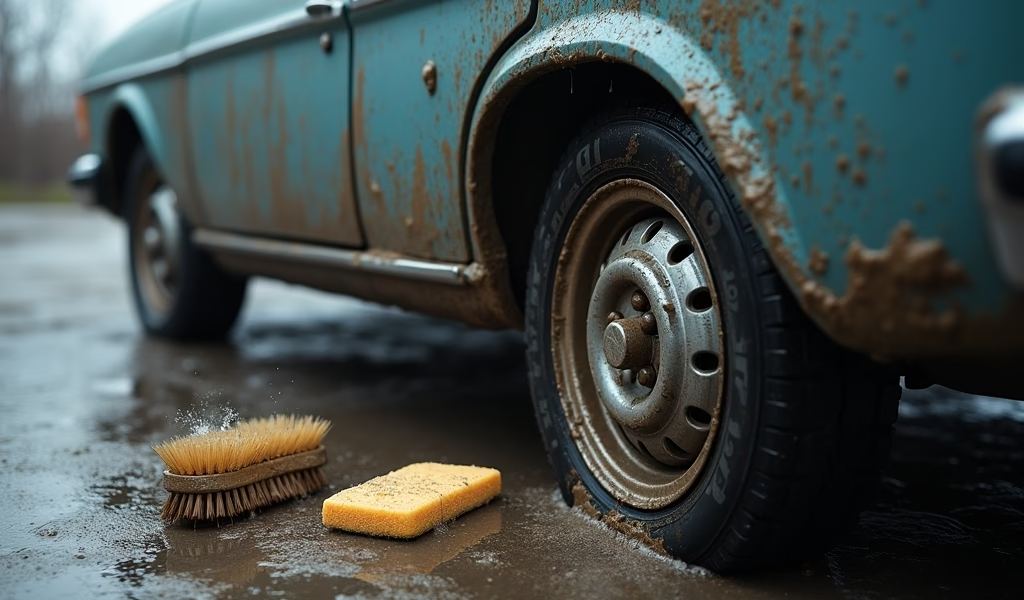Overview
This detailed guide presents seven essential professional-grade car wash tools that protect vehicle paint while delivering superior cleaning results: microfiber wash mitts, two-bucket systems, proper car soaps, pressure washers, quality drying tools, specialized wheel/tire tools, and detailing sprays. The article emphasizes how investing in proper car wash equipment preserves your vehicle’s appearance and value while transforming washing from a potential source of paint damage into an effective maintenance routine.
Table of Contents
- Why Quality Car Wash Tools Matter
- 1. Microfiber Wash Mitts: Your Paint’s Best Friend
- 2. Two-Bucket Washing System: The Professional’s Secret
- 3. Car Wash Soaps: Choosing the Right Formula
- 4. Pressure Washers: Power Without Damage
- 5. Drying Tools: Preventing Water Spots
- 6. Wheel and Tire Tools: Tackling the Dirtiest Parts
- 7. Detailing Sprays: Quick Shine Between Washes
- Maintenance and Care for Your Car Wash Arsenal
- Conclusion: Investing in Quality for the Long Haul
- Frequently Asked Questions
Looking after your vehicle isn’t just about maintaining its mechanical health—it’s also about preserving its appearance. After 15 years in the auto detailing business, I’ve seen firsthand how the right car wash tools can transform both the process and results of washing your vehicle at home. The difference between using professional-grade equipment versus household items is like night and day—not just in how your car looks, but in how long that finish lasts.
Whether you’re a weekend warrior or a dedicated enthusiast, investing in quality car washing equipment pays dividends in both your vehicle’s appearance and its value over time. Let’s dive into the seven tools that have consistently proven their worth in my garage and the garages of countless car enthusiasts I’ve worked with over the years.
Why Quality Car Wash Tools Matter
Your car’s paint is surprisingly delicate. That glossy finish you admire isn’t just for looks—it’s a sophisticated barrier protecting the metal underneath from corrosion and damage. Every time you wash your car with improper tools, you’re potentially creating microscopic scratches that, over time, dull your finish and compromise that protection.
Think about it this way: using a kitchen sponge to wash your car is like using sandpaper on your skin. Both might get the job done, but one’s going to leave damage behind. Professional-grade car wash tools are specifically engineered to clean effectively while minimizing the risk of scratching or marring your vehicle’s finish.
Beyond protecting your paint, quality tools also:
- Save time by cleaning more efficiently
- Reduce water consumption through better design
- Last longer, making them more economical in the long run
- Deliver consistent results wash after wash
When clients ask if investing in proper tools is worth it, I remind them that professional detailing services can run $150-300 per session. A complete set of quality car wash kit essentials costs roughly the same—but lasts for dozens of washes. The math simply makes sense.

1. Microfiber Wash Mitts: Your Paint’s Best Friend
If there’s one tool that separates professionals from amateurs, it’s the humble wash mitt. Toss out those yellow sponges and cotton rags—they’re paint killers. Microfiber wash mitts feature thousands of tiny fibers that lift dirt away from your paint rather than grinding it in.
What makes a good wash mitt? Look for these qualities:
- Dense, plush microfiber with a deep pile (7-10mm is ideal)
- Excellent water retention to keep soap solution against the paint
- A snug fit on your hand for controlled application
- Durable stitching that won’t come apart after a few washes
In my professional kit, I keep separate mitts for different vehicle areas. One premium mitt handles only the upper panels, while a second tackles lower sections that typically collect more road grime. This prevents transferring heavier contaminants to cleaner areas.
For most home detailers, the Meguiar’s X3002 Microfiber Mitt or the Chemical Guys Chenille Microfiber Mitt offer excellent performance at reasonable prices. If you’re willing to splurge a bit, a genuine lambswool mitt provides unparalleled softness and dirt-trapping capabilities.
2. Two-Bucket Washing System: The Professional’s Secret
Nothing screams “amateur” louder than washing an entire car with a single bucket of increasingly dirty water. The two-bucket method is a game-changer that prevents you from redepositing grit back onto your clean paint.
Here’s how it works:
- Bucket #1: Contains your soap solution
- Bucket #2: Contains clean rinse water
- After each panel, rinse your mitt in the clean water bucket before reloading with soap
- This keeps your soap solution cleaner throughout the wash
Take this system to the next level by adding grit guards to both buckets. These plastic grids sit at the bottom and prevent dirt from being stirred back up when you dunk your mitt. Any particles settle below the guard, keeping them away from your mitt and, consequently, your paint.
Color-coded buckets are worth the small extra investment—I use blue for soap and red for rinse water. When you’re in the zone washing your vehicle, this simple visual cue prevents mixing up the buckets. For even better results, use five-gallon buckets rather than smaller options, as they provide more water volume to dilute contaminants.
3. Car Wash Soaps: Choosing the Right Formula
Let’s clear up a persistent myth right away: dish soap is not an acceptable car wash solution. Ever. Dish detergents are designed to cut grease and strip away residue—exactly what you don’t want for your car’s finish. They’ll remove protective waxes and sealants, leaving your paint vulnerable.
Proper automotive wash soaps are pH-balanced formulations that clean effectively while preserving your vehicle’s protective layers. They create lubrication that helps dirt particles glide off the surface rather than scratching it.
When selecting a wash soap, consider:
- pH balance (neutral is best for most applications)
- Sudsing capability (more suds = better lubrication)
- Concentration level (more concentrated formulas offer better value)
- Compatibility with any sealants or coatings you’ve applied
For vehicles with traditional wax protection, Meguiar’s Gold Class and Chemical Guys Mr. Pink consistently deliver excellent results. If your vehicle has a ceramic coating, specialized wash soaps like Gyeon Bathe+ or CarPro Reset are formulated to work harmoniously with these advanced protectants without degrading their performance.
The correct dilution ratio matters significantly—too much soap can leave residue, while too little won’t provide adequate cleaning power or lubrication. Follow the manufacturer’s guidelines, which typically call for 1-2 ounces of concentrated soap per gallon of water.
4. Pressure Washers: Power Without Damage
A pressure washer can be your best ally or your paint’s worst enemy—it all depends on how you use it. When applied correctly, pressurized water removes loose contaminants without physical contact, significantly reducing the risk of scratching during the wash process.
The key is finding the right balance of power. For automotive use, I recommend electric pressure washers in the 1300-1900 PSI range. This provides enough force to dislodge dirt without risking damage to trim, emblems, or vulnerable components.
Essential pressure washer features include:
- Variable pressure settings to adjust for different vehicle areas
- Multiple nozzle options (40-degree nozzles are safest for vehicles)
- Foam cannon compatibility for pre-washing
- Manageable size and weight for maneuvering around your vehicle
Speaking of foam cannons, this attachment transforms your pressure washer into a professional pre-washing system. By applying a thick layer of foam that dwells on the surface for 5-10 minutes, you’ll soften and lift away a significant amount of dirt before ever touching the paint with your wash mitt.
For most home detailers, the Sun Joe SPX3000 offers an excellent balance of performance and value, while the Karcher K5 provides more premium features for serious enthusiasts. Pair either with a quality foam cannon like the MATCC Adjustable Foam Cannon for professional-grade results.
5. Drying Tools: Preventing Water Spots
The drying phase is where many DIY detailers falter, leaving their otherwise clean vehicles marred by water spots. These seemingly innocuous marks are actually mineral deposits that can etch into your clear coat if left untreated, especially in areas with hard water.
Professional-grade microfiber drying towels are the foundation of proper drying technique. Unlike bath towels or chamois leathers, these specialized fabrics:
- Absorb up to 10 times their weight in water
- Feature split fibers that create tremendous surface area for absorption
- Provide a gentle touch that won’t mar freshly washed surfaces
- Can be laundered and reused dozens of times when properly maintained
Look for drying towels with a GSM (grams per square meter) rating of 350-400 for general use, or 600-1200 GSM for premium “waffle weave” or “twisted loop” designs specifically engineered for maximum absorption. Size matters too—a 25″ × 36″ towel provides ample coverage for efficiently drying larger panels.
For the absolute safest drying experience, consider an automotive dryer like the MetroVac Air Force Blaster or the more budget-friendly Chemical Guys TORQ Professional Blower. These tools force water off your vehicle without any physical contact, eliminating even the minimal risk of marring that comes with towel drying.

6. Wheel and Tire Tools: Tackling the Dirtiest Parts
Your wheels collect the most punishing combination of contaminants: brake dust (which is actually tiny metal particles), road tar, and environmental grime. This toxic mixture requires specialized tools designed to clean effectively without damaging expensive wheel finishes.
A proper wheel cleaning arsenal includes:
- Wheel-specific brushes with soft bristles for painted or delicate finishes
- Long-handled brushes that can reach behind spokes and into barrel areas
- Stiff-bristled tire brushes designed specifically for rubber surfaces
- Wheel woolies or similar tools for reaching into tight recesses
In my professional detail bay, we use different brushes for different wheel types. The EZ Detail Brush has earned its reputation for reaching deep into wheel barrels without scratching, while dedicated tire brushes like the Tuf Shine Tire Brush make quick work of embedded grime in rubber surfaces.
Pair these tools with wheel-specific cleaning solutions matched to your wheel type. All-purpose cleaners work for most wheels, but ceramic-coated or particularly delicate finishes benefit from pH-neutral formulations that clean effectively without compromising protective treatments. For extremely dirty wheels, consider a car wash specific iron remover that chemically dissolves brake dust particles rather than requiring aggressive scrubbing.
7. Detailing Sprays: Quick Shine Between Washes
Even with a regular washing schedule, your vehicle will collect dust and light contaminants between full cleanings. Detailing sprays bridge this gap, allowing you to maintain that just-washed appearance without breaking out all your washing equipment.
These versatile products fall into two main categories:
- Quick detailers: Primarily for dust removal and light cleaning
- Spray waxes: Offer cleaning plus additional protection and gloss
Both types require high-quality microfiber towels for application—standard terry cloth or paper towels will cause scratching. Fold your microfiber into quarters to create multiple clean surfaces you can rotate through as you work.
For routine dust removal between washes, Meguiar’s Ultimate Quik Detailer provides excellent lubrication and cleaning power. If you’re looking for something that adds protection along with cleaning ability, Chemical Guys Hybrid V7 or Turtle Wax Ice Spray Wax create noticeable gloss while extending the life of your underlying protection.
The application technique matters just as much as the product itself. Spray detailing products onto your microfiber towel rather than directly onto the vehicle to prevent streaking and product waste. Work in small sections, using light pressure and straight-line motions rather than circular patterns.
Maintenance and Care for Your Car Wash Arsenal
Your car washing tools need regular maintenance to perform at their best. Neglected equipment can actually become a source of paint damage rather than protection.
After each wash session:
- Rinse wash mitts and microfiber thoroughly to remove trapped particles
- Wash microfiber products separately from regular laundry
- Skip the fabric softener, which coats fibers and reduces absorbency
- Allow all tools to dry completely before storage to prevent mildew
- Inspect brushes for wear and bristle damage
Establish a replacement schedule for wear items. Even with proper care, wash mitts typically need replacement every 8-12 months with regular use. Microfiber towels can last 2-3 years if properly maintained, but should be relegated to less critical tasks (like engine bay cleaning) once they start showing signs of wear.
I recommend keeping dedicated storage for your detailing supplies—a simple plastic tote works well for smaller items, while a rolling cart provides the ultimate organization for more extensive collections. Proper storage prevents cross-contamination between products and protects your investment from damage.
Conclusion: Investing in Quality for the Long Haul
After decades in the automotive care industry, I’ve watched countless car enthusiasts transform their washing routine by upgrading from household items to professional-grade car wash products. The difference isn’t just visible in the short term—it compounds over months and years as your vehicle’s finish remains protected from the microscopic damage that dull’s its appearance.
The seven essential tools we’ve covered represent the core of what’s needed for professional-quality results at home:
- Microfiber wash mitts for safe contact cleaning
- Two-bucket systems to prevent contamination and swirls
- pH-balanced car wash soaps that clean without stripping protection
- Pressure washers for efficient pre-cleaning without contact
- Quality drying tools to prevent water spots and mineral etching
- Specialized wheel and tire tools for the dirtiest vehicle areas
- Detailing sprays for maintaining appearance between washes
While this might seem like a significant investment compared to grabbing whatever’s under the kitchen sink, consider the long-term value: these tools help preserve your vehicle’s appearance, protect its resale value, and transform car washing from a chore into a satisfying ritual that connects you with your ride.
Start with the basics if budget is a concern—a quality wash mitt, proper car soap, and good drying towels will dramatically improve your results even before adding the other tools. As you experience the difference in both process and results, you’ll likely find yourself naturally expanding your detailing arsenal.
Remember, caring for your car isn’t just about keeping it clean—it’s about preserving both its appearance and value for the long road ahead.
Frequently Asked Questions
How often should I wash my car with these professional tools?
Most vehicles benefit from washing every 2-3 weeks under normal conditions. Adjust more frequently if your vehicle is exposed to harsh elements like road salt, bird droppings, or tree sap.
Can I use regular household towels instead of microfiber for drying?
Never use household bath towels on automotive paint as they can cause microscopic scratches. Microfiber towels designed specifically for automotive use have a safe, split-fiber structure that prevents marring.
Is a pressure washer really necessary for home car washing?
While not absolutely essential, a pressure washer dramatically improves pre-washing effectiveness by removing loose contaminants before contact washing. It also reduces the physical scrubbing needed, which means less risk of scratching.
What’s the best order of operations when washing a car?
Always work top-down: wheels last, roof and upper panels first. This prevents transferring heavier contaminants from dirtier lower areas to cleaner upper sections.
Are automatic car washes with these brushes safe for my paint?
Automatic car washes with rotating brushes should generally be avoided as they can cause swirl marks and scratches. Touchless automatic washes are safer but still don’t match the quality of a proper hand wash with appropriate tools.

